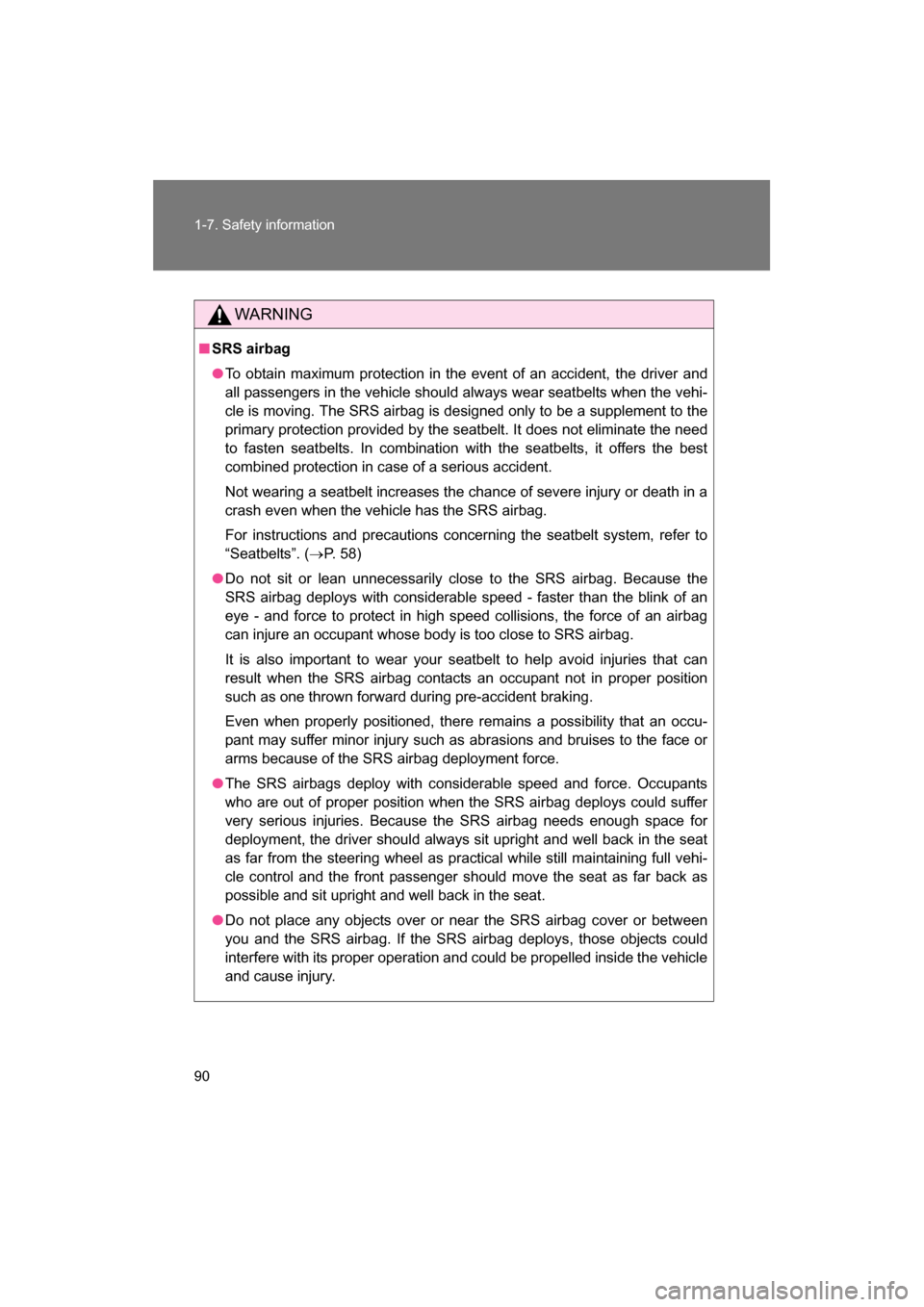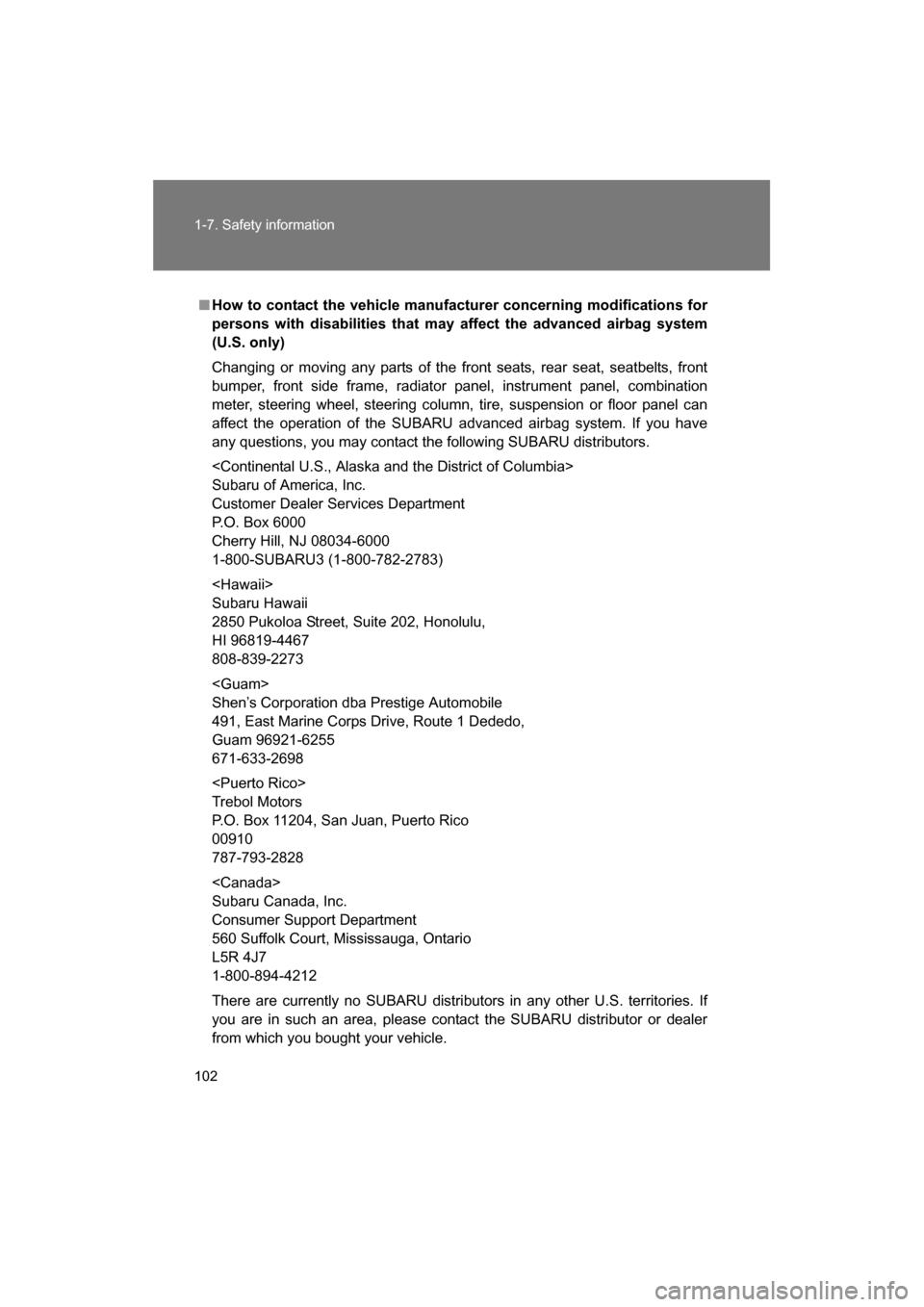Page 90 of 488

90
1-7. Safety information
WARNING
■SRS airbag
●To obtain maximum protection in the event of an accident, the driver and
all passengers in the vehicle should always wear seatbelts when the vehi-
cle is moving. The SRS airbag is designed only to be a supplement to the
primary protection provided by the seatbelt. It does not eliminate the need
to fasten seatbelts. In combination with the seatbelts, it offers the best
combined protection in case of a serious accident.
Not wearing a seatbelt increases the chance of severe injury or death in a
crash even when the vehicle has the SRS airbag.
For instructions and precautions concerning the seatbelt system, refer to
“Seatbelts”. (→P. 58)
●Do not sit or lean unnecessarily close to the SRS airbag. Because the
SRS airbag deploys with considerable speed - faster than the blink of an
eye - and force to protect in high speed collisions, the force of an airbag
can injure an occupant whose body is too close to SRS airbag.
It is also important to wear your seatbelt to help avoid injuries that can
result when the SRS airbag contacts an occupant not in proper position
such as one thrown forward during pre-accident braking.
Even when properly positioned, there remains a possibility that an occu-
pant may suffer minor injury such as abrasions and bruises to the face or
arms because of the SRS airbag deployment force.
●The SRS airbags deploy with considerable speed and force. Occupants
who are out of proper position when the SRS airbag deploys could suffer
very serious injuries. Because the SRS airbag needs enough space for
deployment, the driver should always sit upright and well back in the seat
as far from the steering wheel as practical while still maintaining full vehi-
cle control and the front passenger should move the seat as far back as
possible and sit upright and well back in the seat.
●Do not place any objects over or near the SRS airbag cover or between
you and the SRS airbag. If the SRS airbag deploys, those objects could
interfere with its proper operation and could be propelled inside the vehicle
and cause injury.
Page 94 of 488

94
1-7. Safety information
Your vehicle is equipped with ADVANCED AIRBAGS designed based
on US motor vehicle safety standards (FMVSS208). The airbag sys-
tem controls airbag deployment power for the driver and front pas-
senger. The front passenger's airbag system consists of the front
passenger occupant detection control module etc.
The main SRS airbag system components are shown above. The
SRS airbag system is controlled by the airbag control module. The
airbag control module consists of an airbag sensor.
In certain types of severe front or side impacts, the SRS airbag sys-
tem triggers the airbag inflators. A chemical reaction in the inflators
quickly fills the airbags with non-toxic gas to help restrain the motion
of the occupants.
Side airbag sensor (center
pillar left-hand side)
Side airbag module (driver’s
side)
Door impact sensor (left-
hand side)Airbag control module
(including impact sensors)
Front sub sensor (left-hand
side)
Curtain airbag module (left
side)
■If the SRS airbags deploy (inflate)
●Bruising and slight abrasions may result from contact with a deploying
(inflating) SRS airbag.
●A loud noise and white powder will be emitted.
●Parts of the airbag module (steering wheel hub, airbag cover and inflator)
as well as the front seats, parts of the front and rear pillars, and roof side
rails, may be hot for several minutes. The airbag itself may also be hot.
●The windshield may crack.
Page 95 of 488

95
1-7. Safety information
1
Before driving
SUBARU advanced frontal airbag systemYour vehicle is equipped with a SUBARU advanced frontal airbag
system that complies with the new advanced frontal airbag require-
ments in the amended Federal Motor Vehicle Safety Standard
(FMVSS) No. 208.
The SUBARU advanced frontal airbag system automatically deter-
mines the deployment force of the driver’s SRS frontal airbag at the
time of deployment as well as whether or not to activate the front pas-
senger’s SRS frontal airbag and, if activated, the deployment force of
the SRS frontal airbag at the time of deployment.
Your vehicle has warning labels on the driver’s and front passenger’s
sun visors beginning with the phrase “EVEN WITH ADVANCED AIR
BAGS” and a tag attached to the glove box lid beginning with the
phrase “Even with Advanced Air Bags”. Make sure that you carefully
read the instructions on the warning labels and tag.
Always wear your seatbelt. The SUBARU advanced frontal airbag
system is a supplemental restraint system and must be used in com-
bination with a seatbelt. All occupants should wear a seatbelt or be
seated in an appropriate child restraint system.
The driver’s SRS frontal airbag is stowed in the center portion of the
steering wheel. The front passenger’s SRS frontal airbag is stowed
near the top of the dashboard under an “SRS AIRBAG” mark.
In a moderate to severe frontal collision, the following components
deploy. ● SRS frontal airbag for driver
● SRS frontal airbag for front passenger
These components supplement the seatbelts by reducing the impact
to the occupant’s head and chest.
Page 102 of 488

102
1-7. Safety information
■How to contact the vehicle manufacturer concerning modifications for
persons with disabilities that may affect the advanced airbag system
(U.S. only)
Changing or moving any parts of the front seats, rear seat, seatbelts, front
bumper, front side frame, radiator p anel, instrument panel, combination
meter, steering wheel, steering column, tire, suspension or floor panel can
affect the operation of the SUBARU advanced airbag system. If you have
any questions, you may contact the following SUBARU distributors.
Subaru of America, Inc.
Customer Dealer Services Department
P.O. Box 6000
Cherry Hill, NJ 08034-6000
1-800-SUBARU3 (1-800-782-2783)
Subaru Hawaii
2850 Pukoloa Street, Suite 202, Honolulu, HI 96819-4467 808-839-2273
Shen’s Corporation dba Prestige Automobile
491, East Marine Corps Drive, Route 1 Dededo,
Guam 96921-6255 671-633-2698
Trebol Motors
P.O. Box 11204, San Juan, Puerto Rico 00910 787-793-2828
Subaru Canada, Inc.
Consumer Support Department
560 Suffolk Court, Mississauga, Ontario
L5R 4J7
1-800-894-4212
There are currently no SUBARU distributors in any other U.S. territories. If
you are in such an area, please contact the SUBARU distributor or dealer
from which you bought your vehicle.
Page 109 of 488
109
1-7. Safety information
1
Before driving
WARNING
■If the SRS airbags deploy
Do not touch the SRS airbag system components around the steering wheel
and dashboard with bare hands right after deployment. Doing so can cause
burns because the components can be very hot as a result of deployment.
■Child restraint precautions
NEVER INSTALL A REARWARD FACING CHILD SEAT IN THE FRONT
PASSENGER’S SEAT EVEN IF THE FRONT PASSENGER’S SRS FRON-
TAL AIRBAG IS DEACTIVATED. Be sure to install it in the REAR seat in a
correct manner. Also, it is strongly recommended that any forward facing
child seat or booster seat be installed in the REAR seat, and that even chil-
dren who have outgrown a child restraint system be also seated in the
REAR seat. This is because children sitting in the front passenger’s seat
may be killed or severely injured should the front passenger’s SRS frontal
airbag deploy. REAR seats are the safest place for children.
Page 111 of 488

111
1-7. Safety information
1
Before driving
■Operation
The SRS side airbag and SRS curtain airbag can function only when the
ignition switch is in the “ON” position.
The driver’s and front passenger’s SRS side airbags and SRS curtain air-
bags deploy independently of each other since each has its own impact sen-
sor. Therefore, they may not both deploy in the same accident. Also, the
SRS side airbag and SRS curtain airbag deploys independently of the
driver’s and front passenger’s SRS front airbags in the steering wheel and
instrument panel.
An impact sensor, which senses impact force, is located in each of the left
and right center pillars, doors and rear wheel houses. Another impact sen-
sor, which also senses impact force, is located under the center of the rear
seats.
If the impact sensor that is located under the center of the rear seats and
one of the center pillar impact sens ors or door impact sensors together
sense an impact force above a predetermined level in a side collision, the
control module causes both the SRS side airbag and curtain airbag on the
impacted side to inflate regardless of whether the rear wheel house impact
sensor on the same side senses an impact.
If the impact sensor that is located under the center of the rear seats and
one of the rear wheel house impact sensors together sense an impact force
above a predetermined level, the control module causes only the SRS cur-
tain airbag on the impacted side to inflate.
After the deployment, the SRS side airbag immediately starts to deflate. The
time required from detection of an impact to deflation of an SRS side airbag
after deployment is shorter than the blink of an eye.
The SRS curtain airbag remains inflated for a while following deployment
then slowly deflates.
Page 116 of 488
116
1-7. Safety information
●A portion of a door is damaged or
deformed, or the vehicle was involved
in an accident that was not severe
enough to cause the SRS side airbags
and curtain airbags to inflate.
●The pad section of the steering wheel
or dashboard is scratched, cracked, or
otherwise damaged.
●The surface of the seats with the side
airbag is scratched, cracked, or other-
wise damaged.
●The portion of the front pillars, rear pil-
lars or roof side rail garnishes (padding)
containing the curtain airbags inside is
scratched, cracked or otherwise dam-aged.
Page 117 of 488
117
1-7. Safety information
1
Before driving
WARNING
■SRS airbag precautions
Observe the following precautions regarding the SRS airbags.
Failure to do so may cause death or serious injury.
●The driver and all passengers in the vehicle must wear their seatbelts
properly.
The SRS airbags are supplemental devices to be used with the seatbelts.
●The driver should always sit upright and well back in the seat as far from
the steering wheel as practical while still maintaining full vehicle control
and the front passenger should move the seat as far back as possible and
sit upright and well back in the seat.